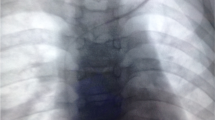Abstract
Purpose
Port-A-Cath devices are frequently used for long-term venous access. We postulate that long-term use predisposes them to getting stuck and retained in a central vein at the time of removal. We aim to report the incidence and outcome of this complication.
Methods
Between January 2006 and July 2016, a retrospective review of all Port-A-Cath removals that were performed at our centre was conducted. At the time of removal, catheters that could not be removed from the vein were considered retained.
Results
During the study period, 107 children had 174 episodes of silicone Sitimplant (Vygon, Ecouen, France) Port-A-Cath insertions. These children required 135 removal episodes and there were 3 (2.2%) instances whereby the catheter fragment was retained. These episodes of retained catheters only occurred in children with factor VIII deficiency (4.1% incidence in this cohort). For each episode of catheter insertion and removal, the catheters had been left in situ for a mean duration of 43 months in children with factor deficiency and no retained fragments, and the mean duration was 91 months in children with factor deficiency and retained catheter fragments (p = 0.0011).
Conclusions
Port-A-Caths that are retained after attempted removal is a complication encountered predominantly in catheters that have been in use for a prolonged duration. Furthermore, factor replacement therapy in haemophiliacs may be a risk factor for this complication.

Similar content being viewed by others
References
Wilson GJP, van Noesel MM, Hop WCJ, van de Ven C (2006) The catheter is stuck: complications experienced during removal of a totally implantable venous access device. A single-center study in 200 children. J Pediatr Surg 41:1694–1698. doi:10.1016/j.jpedsurg.2006.05.065
Bautista F, Gomez-Chacon J, Costa E et al (2010) Retained intravascular fragments after removal of indwelling central venous catheters: a single institution experience. J Pediatr Surg 45:1491–1495. doi:10.1016/j.jpedsurg.2010.02.001
Chan BKY, Rupasinghe SN, Hennessey I et al (2013) Retained central venous lines (CVLs) after attempted removal: an 11-year series and literature review. J Pediatr Surg 48:1887–1891. doi:10.1016/j.jpedsurg.2013.01.050
Chen PC, Chen CJ (2007) Removal of retained Port-A catheter in central lines in a pediatric population. Tzu Chi Med J 19:245–248. doi:10.1016/S1016-3190(10)60023-7
Xiang DZ, Verbeken EK, Van Lommel ATL et al (1998) Composition and formation of the sleeve enveloping a central venous catheter. J Vasc Surg 28:260–271. doi:10.1016/S0741-5214(98)70162-4
Jones SA, Giacomantonio M (2003) A complication associated with central line removal in the pediatric population: retained fixed catheter fragments. J Pediatr Surg 38:594–596. doi:10.1053/jpsu.2003.50129
Milbrandt K, Beaudry P, Anderson R et al (2009) A multiinstitutional review of central venous line complications: retained intravascular fragments. J Pediatr Surg 44:972–976. doi:10.1016/j.jpedsurg.2009.01.033
Quaretti P, Galli F, Fiorina I et al (2014) A refinement of Hong’s technique for the removal of stuck dialysis catheters: an easy solution to a complex problem. J Vasc Access 15:183–188. doi:10.5301/jva.5000186
Ryan SE, Hadziomerovic A, Aquino J et al (2012) Endoluminal dilation technique to remove “stuck” tunneled hemodialysis catheters. J Vasc Interv Radiol 23:1089–1093. doi:10.1016/j.jvir.2012.04.013
Farooq A, Jones V, Agarwal S (2012) Balloon dilatation: a helpful technique for removal of a stuck dialysis line. Cardiovasc Interv Radiol 35:1528–1530. doi:10.1007/s00270-012-0365-5
Hong J (2010) An easy technique for removal of a hemodialysis catheter stuck in central veins. J Vasc Access 11:59–62
Bessoud B, de Baere T, Kuoch V et al (2003) Experience at a single institution with endovascular treatment of mechanical complications caused by implanted central venous access devices in pediatric and adult patients. AJR Am J Roentgenol 180:527–532. doi:10.2214/ajr.180.2.1800527
Dillon PA, Foglia RP (2006) Complications associated with an implantable vascular access device. J Pediatr Surg 41:1582–1587. doi:10.1016/j.jpedsurg.2006.05.022
Oduntan O, Turner J (2013) Empyema thoracis due to intrapleural migration of retained vascular catheter. Ann Thorac Surg 95:e123–e125. doi:10.1016/j.athoracsur.2012.10.076
Surov A, Wienke A, Carter JM et al (2009) Intravascular embolization of venous catheter-causes, clinical signs, and management: a systematic review. J Parenter Enter Nutr 33:677–685. doi:10.1177/0148607109335121
Girolami A, Scandellari R, Zanon E et al (2006) Non-catheter associated venous thrombosis in hemophilia A and B. A critical review of all reported cases. J Thromb Thrombolysis 21:279–284. doi:10.1007/s11239-006-6556-7
Idowu O, Brown J, Kim S, Kim S (2016) Mechanics of a stuck central venous catheter removal. J Pediatr Surg 51:872–875. doi:10.1016/j.jpedsurg.2016.04.001
Lodi M, Ebrahimi RF, Pezzotti P, Carbonari L (2016) The removal of a stuck catheter: an alternative to Hong’s technique. J Vasc Access 17:548–551. doi:10.5301/jva.5000557
Author information
Authors and Affiliations
Corresponding author
Rights and permissions
About this article
Cite this article
Aworanti, O.M., Linnane, N., Tareen, F. et al. Incidence and outcome of retained Port-A-Cath fragments during removal. Pediatr Surg Int 33, 777–781 (2017). https://doi.org/10.1007/s00383-017-4103-6
Accepted:
Published:
Issue Date:
DOI: https://doi.org/10.1007/s00383-017-4103-6



